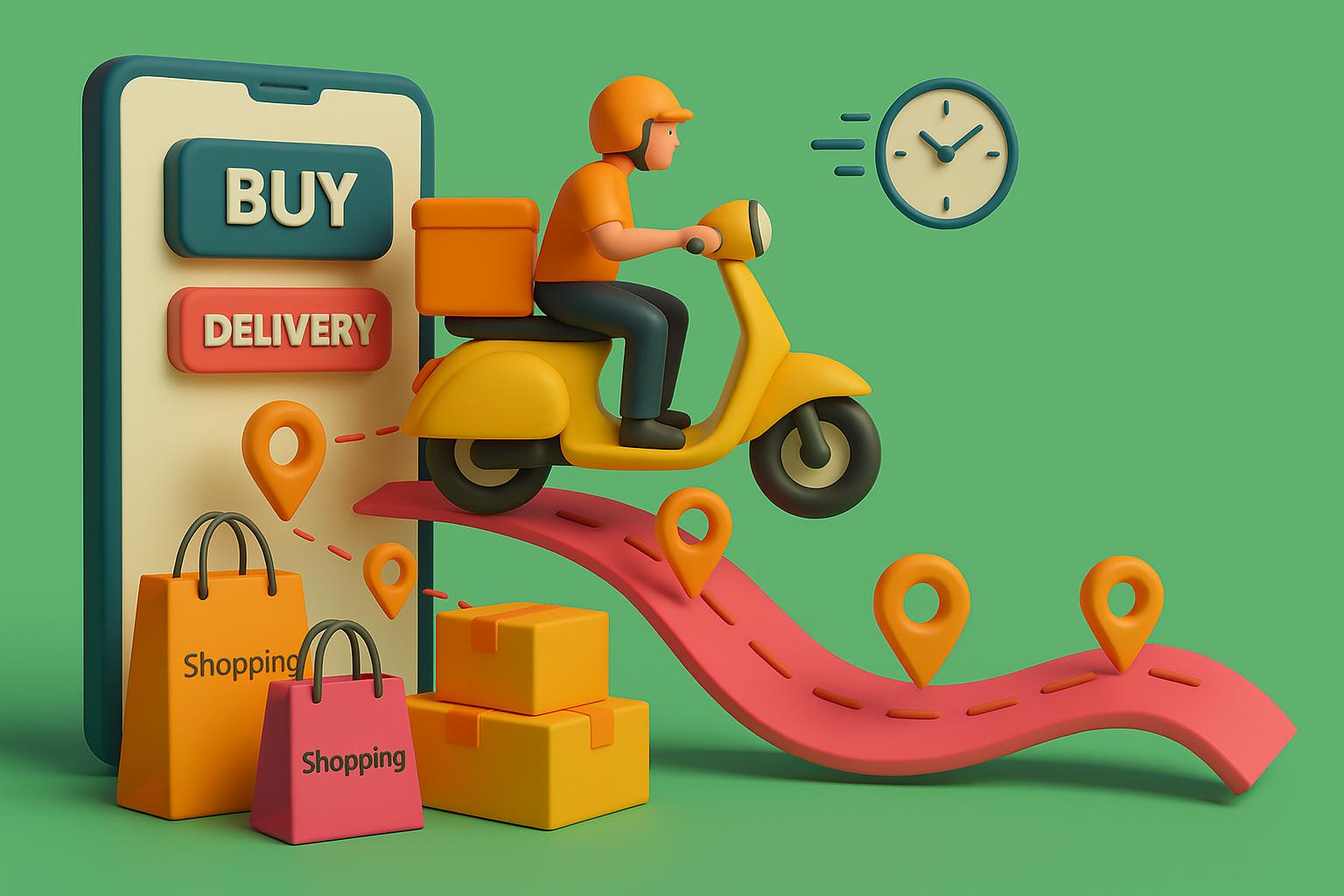Quick Links
ToggleIf you’ve ever opened Blinkit, Zepto, or Instamart and received your groceries in just 10 minutes, you’ve already experienced what quick commerce is all about. Quick commerce, or q-commerce, is changing the way we shop by making instant delivery the new normal. From last-minute snacks to emergency home essentials, these platforms are racing against the clock to deliver your order faster than you can cook a meal.
This growing trend isn’t just a passing phase. According to a 2024 NeilsenIQ survey, 12% of urban consumers now prefer quick commerce, a big jump from just 5% two years ago. Globally, the q-commerce market is expected to reach a massive €448 billion by 2030. Closer to home, India’s quick commerce industry is already valued at USD 3.34 billion in 2024 and is expected to grow to USD 9.95 billion by 2029, growing steadily at over 4.5% each year.
In this article, we’ll take a closer look at what quick commerce really means, how it works behind the scenes, and why it’s becoming such a big deal in cities across the world. Let’s get started.
What is Quick Commerce?
Quick commerce, often referred to as q-commerce, is a fast-growing segment of e-commerce that focuses on delivering goods to customers in a very short time, usually within 10 to 30 minutes. This model caters to the rising demand for instant delivery of everyday essentials such as groceries, snacks, medicines, and personal care products. Quick commerce is particularly popular in urban areas where consumers value speed, convenience, and reliability.
Unlike traditional e-commerce models that may take several hours or days to fulfill orders, quick commerce relies on hyperlocal delivery and hyperlocal inventory, advanced logistics, and technology-driven platforms to ensure rapid delivery. The entire supply chain is optimised to reduce the time between placing an order and receiving it at your doorstep.
Quick Commerce Business Models: Types and How They Work
Industry primarily operates under 2 main quick commerce business models. While both aim to deliver speed and convenience, their approach to inventory management and delivery logistics differs significantly.
-
Delivery-Only Services
In this setup, companies like Swiggy, Zomato, Grab, Pidge, and Shiprocket Quick don’t keep their own stock. Instead, they team up with local stores like supermarkets, convenience stores, or medical shops. When you place an order through their app, they pick it up from one of these partner stores and deliver it to your doorstep. It’s a low-investment model that works fast, especially in areas where there are plenty of stores nearby.
-
Vertically Integrated Operators
Companies like Blinkit, Zepto, Instamart, Dunzo Daily, and BB Now take things a step further. They stock their own inventory in small warehouses called dark stores. These stores are placed close to residential areas to cut down delivery time. Each store usually keeps about 1,000 to 2,000 essential products, which they can adjust depending on what people in that area usually buy. Some platforms are now expanding beyond this range to offer even more variety.
This model gives the company more control over inventory, quality, and pricing. While it costs more to run because of expenses like warehouse rentals, the profit potential is higher too. These companies can make money through delivery charges, by selling their products at a margin, or using a mix of both.
Quick commerce is still growing and evolving. The focus isn’t just on being the fastest, but also on being smart about what customers want and how to deliver it without wasting time or money.
Advantages of Quick Commerce
Here’s how quick commerce is changing the game for both businesses and customers:
-
Fast Delivery Means Happier Customers
Quick commerce stands out because it delivers fast. Customers no longer have to wait days for an order. Whether it’s groceries or essentials, getting them within 10 to 30 minutes feels like magic. This speed makes people happy, keeps them coming back, and builds loyalty in a big way.
-
More Sales, More Growth
When people know they can get what they want instantly, they tend to shop more often. Quick delivery often leads to impulse buys, repeat orders, and higher basket values. For businesses, this means more revenue and a stronger chance of growing faster in a crowded market.
-
Better Control Over Inventory
With a well-planned quick commerce setup, businesses can keep a closer eye on their stock. It helps reduce the chances of popular products running out. This leads to smoother operations, less wastage, and happier customers who always find what they need.
-
Speed is the Superpower
The biggest strength of quick commerce is its speed. Unlike regular eCommerce platforms that may take days, Q-commerce can deliver in just minutes. This suits the needs of today’s fast-moving world, where people expect everything quickly. It upgrades the entire shopping experience.
-
Helps You Stand Out in the Market
In a crowded market, standing out is tough. But if you’re offering faster deliveries and more convenience, customers are going to notice. People love trying new services that make life easier. Quick commerce helps you grab their attention and keep it, giving you an advantage over slower competitors.
-
Better Profits on Small, High-Demand Products
Customers are often ready to pay a bit extra for the comfort of quick delivery. This lets businesses earn more from each order. Also, Q-commerce works well with smaller items that offer higher profit margins, helping companies stay profitable.
-
Smarter, Cheaper Delivery Operations
Quick commerce relies on local warehouses or dark stores placed close to customers. This setup cuts down delivery time and reduces transportation costs. It makes logistics more efficient and affordable, which helps businesses save money and run smoother operations.
-
Quick to Catch Trends and Customer Needs
Q-commerce uses data to understand what customers are buying and when. This helps businesses adjust stock, improve product choices, and respond to changes faster. Being quick to spot and react to customer preferences keeps your business relevant and ahead of the game.
-
Pushing for Greener Choices
Many Q-commerce platforms are going green by using electric vehicles and recyclable packaging. This is good for the planet and also appeals to customers who care about sustainability.
How Can Businesses Implement Quick Commerce?
Here’s how you can set up your business for success in the fast-moving world of Q-commerce:
-
Build a Network of Hyperlocal Warehouses
To reduce delivery time, you need to be closer to your customers. Setting up small, well-placed warehouses or dark stores across high-demand areas allows your team to fulfill orders quickly. These micro-fulfilment centres help you cut down on travel time, restock faster, and serve more customers throughout the day.
-
Offer a Wide Range of Products
Customers turn to quick commerce for more than just groceries. From snacks and personal care items to daily essentials and household goods, variety matters. A broader catalogue not only brings in more orders but also helps you stand out from the competition. The key is to stock high-demand items and manage inventory smartly so that nothing runs out when people need it most.
-
Choose the Right Tech Partner
Quick commerce moves fast. There’s no room for delays, missed orders, or confusion. To keep up, you need systems that don’t slow you down. That’s where Zopping comes in.
Zopping helps you handle the chaos behind the scenes so your customers get a smooth and fast delivery experience with its Hyperlocal Delivery App. Whether it’s picking the right product, packing it properly, or planning the best delivery route, Zopping makes sure nothing slips through the cracks.
Here’s how Zopping makes order fulfilment faster and more reliable:
- Instant Order Prioritisation: Orders are automatically sorted based on urgency, so your team knows exactly what to handle first.
- Barcode-Based Accuracy: Every product picked can be verified with a quick scan, cutting down mistakes and saving time.
- Smart Route Planning: Deliver faster with optimised routes that reduce traffic delays and fuel costs.
- Integrated Packing Tools: Pack orders quickly and print labels in one go, making the process smoother and faster.
- Verified Order Handover: Make sure every order reaches the right customer with secure, proof-based delivery. With Zopping, you don’t just fulfill orders. You build trust with every delivery. Your team stays organised. Your customers stay happy. And your business keeps moving forward, no matter how busy things get.
Want to see how it works in action?
Book a free demo and let us show you how Zopping can transform your fulfillment process.
Book a demoFAQs
What industries are using Q-commerce today?
Q-commerce is growing in retail, grocery, food delivery, pharmacy, and even pet supplies. Any industry that can benefit from fast delivery is getting into quick commerce.
How do Indian Q-commerce brands handle fulfilment challenges?
They use micro-warehouses, real-time inventory tracking, smart routing, and platforms like Zopping to handle high volumes and fast turnaround.
What are dark stores in Q-commerce?
Dark stores are small, offline warehouses set up only for online orders. Customers don’t visit them, but they make quick order fulfillment possible by storing fast-moving items close to the delivery zone.
Can small businesses get into Q-commerce?
Yes. With the right setup and support tools like Zopping, even small businesses can offer fast deliveries and compete with larger players.
Is food delivery considered quick commerce?
Yes. Food delivery is one of the most common types of Q-commerce because it depends heavily on speed and convenience.
Is Zomato part of quick commerce?
Zomato is primarily a food delivery platform but has started tapping into the quick commerce space with grocery and essentials delivery through partnerships and new offerings.
Which companies are leading the quick commerce space in India?
Some of the top names include Blinkit, which delivers in 10 to 20 minutes, Zepto, known for its 10-minute grocery promise, and Swiggy Instamart, offering fast deliveries across major cities.



